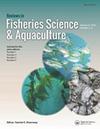Catch Fluctuation of Kuruma Prawn, Penaeus japonicus in Japan Relative to Ocean Climate Variability and a Stock Enhancement Program
引用次数: 17
Abstract
The kuruma prawn, Penaeus japonicus is widely distributed in the Indo-West Pacific. The Japanese stock enhancement program, which produces and releases juvenile kuruma prawns into their natural habitat, started in 1964 and has expanded throughout Japan. The annual number of juveniles released ranged from approximately 240 to 300 million until the mid-1990s but then decreased steadily to approximately 105 million in 2008. National annual landings of kuruma prawns recovered to a record of 3,741 t in 1985 from 1,263 t in 1970 but then declined steadily to the historical minimum of 726 t in 2008. Thus, kuruma prawn catches have decreased dramatically despite the release of juveniles. The aim of this study is to analyze the catch fluctuation of kuruma prawns relative to ocean climate variability and the stock enhancement program. The effects of ocean climate on kuruma prawn stock sizes were evaluated by generalised additive models (GAMs). In the GAMs, catch-per-unit effort and catch data transformed to reduce the dependence of the amplitude of the catch fluctuation on the level of the catch were used as response variables, and three indices for ocean current conditions were used as explanatory variables: the Oyashio (cold current), the Kuroshio (warm current), and the Tsushima Warm Current. The GAM analysis suggested that kuruma prawn stock sizes declined during the period with a strong warm current intensity, and 42 mark-recapture surveys indicated an estimated average yield per release of 0.9 g. Our analysis highlights the fluctuation of kuruma prawn stocks with ocean climate variability and indicates that the stock enhancement program could have an impact on kuruma prawn catches depending on the magnitude of the releases. Ocean climate change, decreased fishing effort, and reduced hatchery releases could be responsible for the recent decline in kuruma prawn catches in Japanese waters.海洋气候变化对日本沼虾渔获量波动的影响及种群增加计划
日本对虾(Penaeus japonicus)广泛分布于印度-西太平洋。日本的种群增加计划始于1964年,该计划生产并释放幼年黑斑对虾到它们的自然栖息地,并在日本各地扩展。直到20世纪90年代中期,每年释放的青少年数量大约在2.4亿到3亿之间,但随后稳步下降,到2008年约为1.05亿。库鲁马对虾的年捕捞量从1970年的1263吨恢复到1985年的3741吨,但随后稳步下降到2008年的历史最低水平726吨。因此,尽管放生幼虾,库鲁玛对虾的捕获量还是急剧下降。本研究的目的是分析与海洋气候变率和种群增加计划相关的黑斑对虾捕获量波动。采用广义加性模型(GAMs)评价了海洋气候对黑鲈对虾种群大小的影响。在GAMs中,以单位渔获量和经过转换的渔获量数据作为响应变量,以减少渔获量波动幅度对渔获量水平的依赖性,并以洋流条件的3个指标作为解释变量:冷流、暖流和对马暖流。GAM分析表明,在暖流强度较强的时期,库uma对虾种群规模下降,42次标记-再捕获调查显示,估计每次释放的平均产量为0.9 g。我们的分析强调了库存量随海洋气候变化的波动,并表明库存量增加计划可能对库存量产生影响,这取决于释放量的大小。海洋气候变化、捕捞努力的减少以及孵化场放放量的减少可能是最近日本水域黑斑对虾捕捞量下降的原因。
本文章由计算机程序翻译,如有差异,请以英文原文为准。
求助全文
约1分钟内获得全文
求助全文

 求助内容:
求助内容: 应助结果提醒方式:
应助结果提醒方式:


